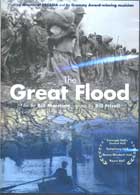
The Great Flood 2013
Distributed by Icarus Films, 32 Court St., 21st Floor, Brooklyn, NY 11201; 800-876-1710
Produced by Phyllis Oyama; Hypnotic Pictures and Songline/Tone Field Productions
Directed by Bill Morrison
DVD, color and b&w, 80 min.
Sr. High - General Adult
Floods, African Americans, Migration, Blues Music, Population, United States HIstory
Date Entered: 12/23/2014
Reviewed by Michael Fein, Coordinator of Library Services, Central Virginia Community College, Lynchburg, VAAt the beginning, let this reviewer state that while he is not as effusive as the reviews quoted on the website for this production, he did genuinely like the film. However, this production is one that is, to this reviewer at least, hard to peg. Is it a film meant to be a vehicle for a jazz piece, or a visual record of the Great Flood of 1927 that happens to have a jazz soundtrack? It is not really a documentary, although the visual portion of the production consists mostly of film shot during the flood. There is no narrative that gives any context to the film, though the different sections are identified by titles and the film itself does have some introductory information presented on the causes of this most destructive flood in the nation’s recorded history. The soundtrack is a jazz piece by Frisell that does not really, in this reviewer’s opinion, add or detract from the viewing experience. The film itself – the views of those suffering, the immensity of the destruction as seen in aerial views and ground views – are amazingly fascinating. As much as people say that they hate destruction and its accompanying suffering, it is still quite fascinating and draws a crowd. This reviewer was able to drown out (no pun intended) the music because of the images of what would have been his grandparents’ generation and their suffering and perseverance in the face of such an enormous catastrophe. One particularly touching scene is of a dog that swims to a roof top and the boat that is shooting film approaches the dog, and, we hope, rescued the dog. The film depicts, as a result of the flood, the migration of African-Americans from the South to the North to make a new life. The final contemporary film shots are of Blues singers in Chicago. The film was all shot with nitrate film which shows obvious signs of deterioration, but does not distract from the viewing. This film is recommended to a wide range of collections: African American studies, U.S. history, Southern studies, film history, music, and costume design, among others.